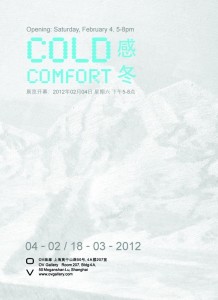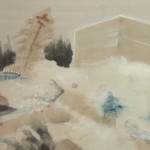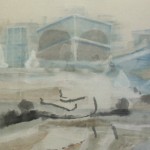Chai Yiming: Untitled, water color and ink on xuan paper with cloth mount, 70 x 100cm, 2010
Winter in Chinese has the connotation of freezing, in a more genteel language we can say that all business has stopped or slowed. The ancients said, “In fall we harvest; in winter we store.” But the word “dong” for winter is also pregnant with the meaning of gathering. The contradictions of life are all present in these seasons. Is there any difference between painting in the winter and painting paintings of winter? Why don’t we let the painting answer that question.
Chen Hangfeng: Artificial Snowflake, Installation, 2011
This stop motion animation records the process of making a collage. The images are of different consumer products, that I cut out from free flyers, leaflets, advertisements and junk mail, which I collected during my residency in Sapporo.
Two mirrors are placed at 60 degree angles and it almost looks like these consumer products are worshiping themselves in the manner of the Shinto goddess Amaterasu. Therefore each collage repeats, which has the effect of looking like a snowflake pattern. The work acts as a tribute to Ukichiro Nakaya, who created the first artificial snowflake in Sapporo. But what will happen if there is no snow in the future?"
Chen Hangfeng: It Comes and Goes
stop motion animation, 1:24 mins, 2011
This stop motion animation records the process of making a collage. The images are of different consumer products, that I cut out from free flyers, leaflets, advertisements and junk mail, which I collected during my residency in Sapporo.
Two mirrors are placed at 60 degree angles and it almost looks like these consumer products are worshiping themselves in the manner of the Shinto goddess Amaterasu. Therefore each collage repeats, which has the effect of looking like a snowflake pattern. The work acts as a tribute to Ukichiro Nakaya, who created the first artificial snowflake in Sapporo. But what will happen if there is no snow in the future?"
Chen Xi: Icebreaker, pigment ink and marker on fabriano paper, 70 X 100cm, 2011, Moon Light, pigment ink on fabriano paper, 50 X 70cm, 2011 Rain and Snow and Sand and Wind mixed, pigment ink on fabriano paper, 50 X 70cm, 2011 破冰船,水彩纸上针管笔马克笔, 70 X 100cm, 2011
I provide a seemingly irrational vision. This refers to the irrationality of the world we all live in ¬– how strange it is to be human, to witness the oddity of living. It refers to the idea that life is meaningless and humorous and that societal narratives are simply constructed illusions developed in order to make living palatable. There are lots of things that happen in my drawings, which point towards how we as humans live in an inexplicable condition that is beyond our control.
Chen Xi: Icebreaker, Moon Light, Rain and Snow and Sand and Wind
ink and pencil on fabriano paper, 70 X 100cm, 2011
ink and pencil on fabriano paper, 50 X 70cm, 2011
ink and pencil on fabriano paper, 50 X 70cm, 2011
I provide a seemingly irrational vision. This refers to the irrationality of the world we all live in – how strange it is to be human, to witness the oddity of living. It refers to the idea that life is meaningless and humorous and that societal narratives are simply constructed illusions developed in order to make living palatable. There are lots of things that happen in my drawings, which point towards how we as humans live in an inexplicable condition that is beyond our control.
Ed Pien: Curious Creatures, 87 x 125 cm, hand-cut digital print on arches paper, 2011, Leap of Faith, 87 x 125 cm, hand-cut digital print on arches paper, 2011
In these two hand-cut digital prints, I continue exploring concerns that I began in this overall series entitled “Blur Cuts.” In the two most recent works, “Curious Creatures” and “Leap of Faith,” there is a note of playfulness. Figures and birds commingle and reside in a natural world where mystery and life forces abound.
Ed Pien: Curious Creatures, Leap of Faith
87 x 125 cm, hand-cut digital print on arches paper, 2011
87 x 125 cm, hand-cut digital print on arches paper, 2011
In these two hand-cut digital prints, I continue exploring concerns that I began in this overall series entitled “Blur Cuts.” In the two most recent works, “Curious Creatures” and “Leap of Faith,” there is a note of playfulness. Figures and birds commingle and reside in a natural world where mystery and life forces abound.
Ge Fei and Lin Zhen: After, Video 3:27 mins, 2008
On the Mongolian Steppes a snowstorm suddenly arises.
Ji Wenyu Zhu Weibing: “No one in the Garden of Eden,” mixed media, 310 x 126 x 87cm, 2010
Inside a two-meter tall mosquito net there is a transparent gauze tree. The elongated roots of the tree extend below the mosquito net and almost touch the floor. The topic is “No One in the Garden of Eden.”
After eating the forbidden fruit, we start from innocence and after that, what did we find? It was from this moment that we began to look for struggle, and at the same time greed emerged. God Very wisely predicted that all would not be peaceful under heaven and angrily cast Adam and Eve from Eden. After this Eden retained its innocence, still beautiful, still flourishing, an unending sea of dazzling brilliance. In order to maintain it or to expand its growth, the tree’s roots needed even more nourishment. They became dense and thick, growing down, and growing long. The started to seek, and the more they sought, the more they found, and they became greedy. Nutrients! Nutrients! And this time God was silent.
Ji Wenyu Zhu Weibing: No one in the Garden of Eden
mixed media, 310 x 126 x 87cm, 2010
Inside a two-meter tall mosquito net there is a transparent gauze tree. The elongated roots of the tree extend below the mosquito net and almost touch the floor. The topic is “No One in the Garden of Eden.”
After eating the forbidden fruit, we start from innocence and after that, what did we find? It was from this moment that we began to look for struggle, and at the same time greed emerged. God Very wisely predicted that all would not be peaceful under heaven and angrily cast Adam and Eve from Eden. After this Eden retained its innocence, still beautiful, still flourishing, an unending sea of dazzling brilliance. In order to maintain it or to expand its growth, the tree’s roots needed even more nourishment. They became dense and thick, growing down, and growing long. The started to seek, and the more they sought, the more they found, and they became greedy. Nutrients! Nutrients! And this time God was silent.
Monika Lin: Take-Away, rice, resin, masking tape, dimensions variable, 2012
Six years ago, after having encountered grain vendors on almost every block of my neighborhood I began thinking actively about "rice economies." This term refers to countries and regions with low labor costs, as it is labor-intensive to cultivate rice. The vendors in my neighborhood offer various price points, qualities and varieties of rice, all of which brought to mind further questions about the nature of "rice economies" and their specific values and consequences. This eventually led me to the idea of rice itself as a medium.
The neighborhood street vendors who offer quick, cheap street meals in my neighborhood offered another key point of departure in this vein of exploration. These “economy rice” meals, targeting the working population, typically offer anywhere from 10-15 troughs of pre-cooked food including meat, vegetables, eggs and tofu. Customers select a combination, which is served accompanied by a portion of steamed white rice in a Styrofoam container.
In contrast, the plastic to-go containers I have utilized here are used to carry out/deliver food from higher-end restaurants. As a pack-rat, I had amassed a large quantity of them (whereas I would throw away the Styrofoam containers). As I delved further into thinking about the economics of food, I started to experiment with using rice as a medium and the plastic take-away boxes as the containing form. The result is a series of pieces made from mundane materials using a commonplace subject, trees, as a means to explore the tension between perceived high art and a popular/craft aesthetic while addressing themes of waste, the economy and labor, as well as the function of the gallery space.
Monika Lin: Take-Away
rice, resin, masking tape, dimensions variable, 2012
Six years ago, after having encountered grain vendors on almost every block of my neighborhood I began thinking actively about "rice economies." This term refers to countries and regions with low labor costs, as it is labor-intensive to cultivate rice. The vendors in my neighborhood offer various price points, qualities and varieties of rice, all of which brought to mind further questions about the nature of "rice economies" and their specific values and consequences. This eventually led me to the idea of rice itself as a medium.
The neighborhood street vendors who offer quick, cheap street meals in my neighborhood offered another key point of departure in this vein of exploration. These “economy rice” meals, targeting the working population, typically offer anywhere from 10-15 troughs of pre-cooked food including meat, vegetables, eggs and tofu. Customers select a combination, which is served accompanied by a portion of steamed white rice in a Styrofoam container.
In contrast, the plastic to-go containers I have utilized here are used to carry out/deliver food from higher-end restaurants. As a pack-rat, I had amassed a large quantity of them (whereas I would throw away the Styrofoam containers). As I delved further into thinking about the economics of food, I started to experiment with using rice as a medium and the plastic take-away boxes as the containing form. The result is a series of pieces made from mundane materials using a commonplace subject, trees, as a means to explore the tension between perceived high art and a popular/craft aesthetic while addressing themes of waste, the economy and labor, as well as the function of the gallery space.
Shi Jing: White Line, oil on canvas, 60cm, 2006
This work is called “White Line” 2006 (there are 16 in total). These works emerged from a global study of glaciers and oceans. The surface of the water in this work and in all the other 15 works is at the same level. Now this water and these iceburgs have already dispersed to different corners of the globe.
Shi Jing: White Line
oil on canvas, 60cm, 2006
This work is called “White Line” 2006 (there are 16 in total). These works emerged from a global study of glaciers and oceans. The surface of the water in this work and in all the other 15 works is at the same level. Now this water and these iceburgs have already dispersed to different corners of the globe.
Wang Taocheng: Sister
chinese ink, pencil
180 × 33 cm, 2009
This piece reflects the suicide of one of my friends’ younger sisters. She told me this story one day on the bus to Pudong (a suburb of Shanghai). The basic problem was that girl's mother was a dictator, making all the decisions, and she was not able to do any of the things that she wanted to do. Because she was from such a poor family, she felt oppressed and developed a sense of inferiority.
Speaking from the mother’s point of view, no one can say she doesn't love her daughter. She had a terrible education and she was biased and blind to how this treatment affected her daughter. She only knows how to make noodles and bargain at the market; the world that surrounds her is very crude and unsophisticated.
Zhu Ye: Solitude, 70 x 50cm, acrylic on canvas, 2011
There are one or two barely perceptible figures in the center of the painting who look as if maybe they are swimming. In this work I’ve created a scene of peace and solitude which is inspired by a Japanese Zen garden.
Zhu Ye: Solitude
70 x 50cm, acrylic on canvas, 2011
There are one or two barely perceptible figures in the center of the painting who look as if maybe they are swimming. In this work I’ve created a scene of peace and solitude which is inspired by a Japanese Zen garden.




,2011,Ed-Pien-Curious-Creatures-check-dimensions-hand-cut-digital-print-on-arches-paper-150x150.jpg)
















